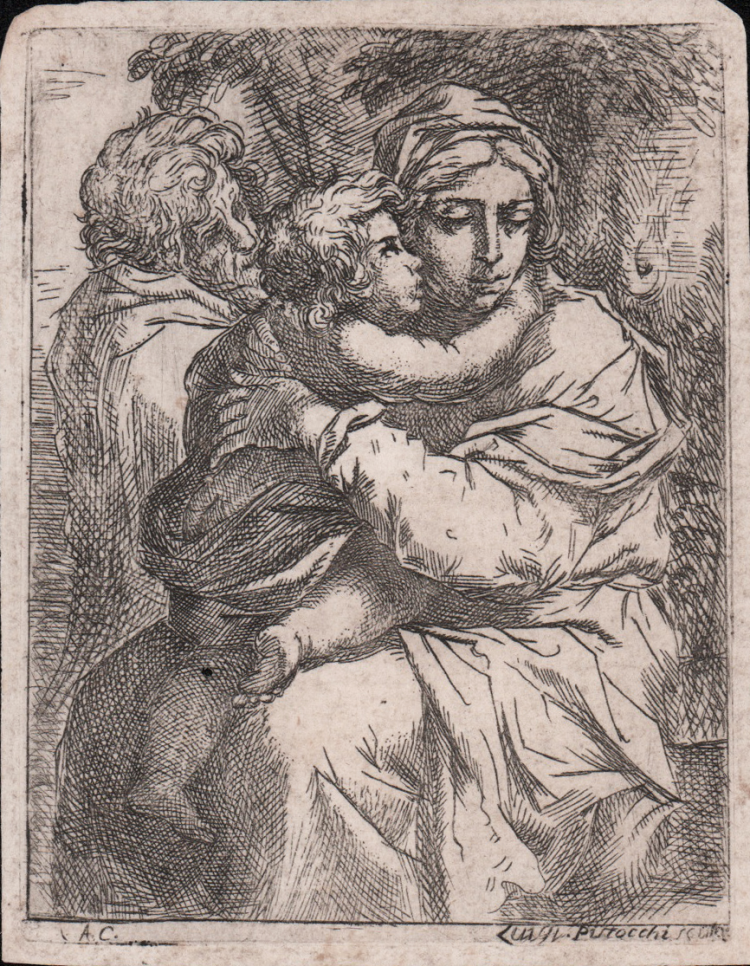




| Reference: | S47137 |
| Author | Luigi PISTOCCHI |
| Year: | 1770 ca. |
| Measures: | 70 x 90 mm |



| Reference: | S47137 |
| Author | Luigi PISTOCCHI |
| Year: | 1770 ca. |
| Measures: | 70 x 90 mm |
Etching, second half of the 18th century, signed in plate at lower right Luigi Pistocchi.
From a subject by Domenico Peruzzini (Bartsch n. 1), from which it appears to be a counterpart copy.
Specimen in the second state of two described by Zeno Davoli, with the signature Luigi Pistocchi and the initials “A. C.” at lower right.
“Copy in counterpart and of the same dimensions from Domenico Peruzzini (see Illustrated Bartsch, vol. 47, p. 136, no. 1). The initials A.C. would indicate as artista inventor Annibale Carracci. In state II, signatures were added and the outline was completed to the left and lower right and left. Angelo Davoli saw at the Forli Municipal Library a specimen that instead of the signature “Luigi Pistocchi” bore “A. Pistocchi.” We think that A. means Aloysius, that is, Luigi, and that it is simply a still different state” (cf. Zeno Davoli, La raccolta di stampe Angelo Davoli p. 291, no. 26281).
Luigi Pistocchi (Faenza, 1749 - Florence, post-1825) was an Italian painter. Very little is known about this painter. He was born into a Faenza family with long artistic traditions, among whose members should be noted his brother Giuseppe, who distinguished himself as an architect, and another Lodovico, also a painter. Between 1772 and 1781 he worked in Pesaro at the workshop of local painter Giovanni Andrea Lazzarini. During that period they frescoed several palaces in the city. He also worked in Rome with Pompeo Batoni and eventually moved to Florence.
It was precisely in Florence that the Gazzetta universale, or Universal Gazette, or sieno, Volume 14, of 1787 wrote of him: “Con molto concorso di Nobiltà, Cittadinanza, e Professori si adunò la nostra R. Accademia delle Belle Arti, la mattina del dì 16, per conferire gli annuali premi: quello di prima classe nella Pittura fu ottenuto dal Sig. Luigi Pistocchi Faentino, che colorita aveva la Storia della morte di Lucrezia Romana”.
Of his entire activity only three works are certain: the Assumption, a canvas kept in the Church of Santa Maria in Argiano, the fresco depicting the Glory of St. Cassiano placed in the Collegiate Church of San Cassiano in San Casciano in Val di Pesa. The third painting depicted St. Hilary freeing the possessed woman but in 1825 was changed to a St. Nicholas of Bari.
He also evidently devoted himself to engraving; note his derivation of Guido Reni's Holy Family.
Good proof, printed on contemporary laid paper, with thin margins, very small wormhole in center, otherwise in good condition.
Very rare work.
Bibliografia
Zeno Davoli, La raccolta di stampe Angelo Davoli, p. 291, n. 26281, II/II.
Luigi PISTOCCHI (Faenza, 1749 – Firenze, post 1825)
|
Very little information remains about this painter. He was born into a family from Faenza with long artistic traditions, including his brother Giuseppe, architect, and another Lodovico, also a painter.
Between 1772 and 1781 he worked in Pesaro at the workshop of the local painter Giovanni Andrea Lazzarini. During that period they frescoed some of the city's buildings. He also worked in Rome with Pompeo Batoni and finally moved to Florence.
|
Luigi PISTOCCHI (Faenza, 1749 – Firenze, post 1825)
|
Very little information remains about this painter. He was born into a family from Faenza with long artistic traditions, including his brother Giuseppe, architect, and another Lodovico, also a painter.
Between 1772 and 1781 he worked in Pesaro at the workshop of the local painter Giovanni Andrea Lazzarini. During that period they frescoed some of the city's buildings. He also worked in Rome with Pompeo Batoni and finally moved to Florence.
|